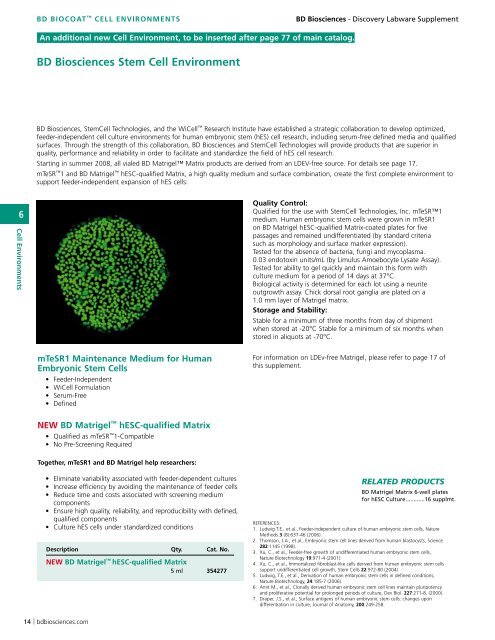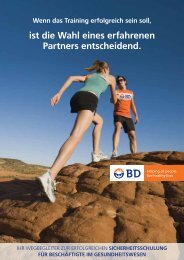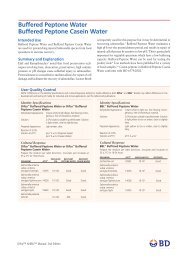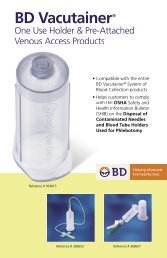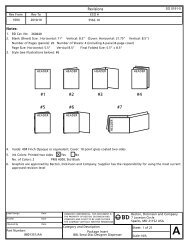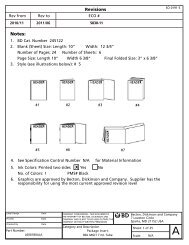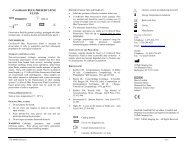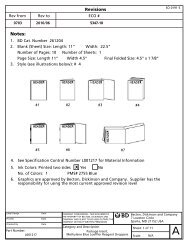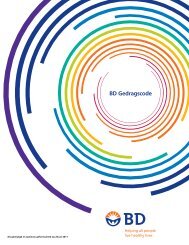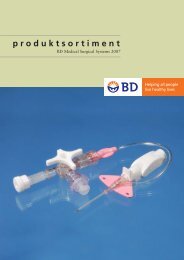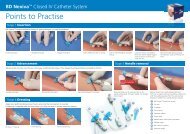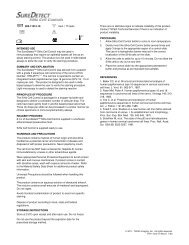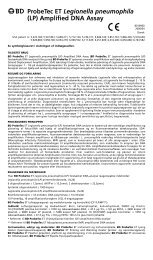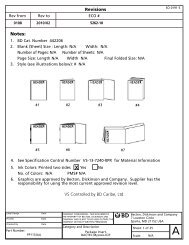Tubes - BD
Tubes - BD
Tubes - BD
Create successful ePaper yourself
Turn your PDF publications into a flip-book with our unique Google optimized e-Paper software.
6<br />
Cell Environments<br />
14<br />
<strong>BD</strong> BIOCOAT CELL ENVIRONMENTS<br />
Page An additional 92 of main new catalog. Cell Environment, to be inserted after page 77 of main catalog.<br />
<strong>BD</strong> Biosciences Stem Cell Environment<br />
Description Qty. Cat. No.<br />
NEW <strong>BD</strong> Matrigel hESC-qualified Matrix<br />
5 ml 354277<br />
bdbiosciences.com<br />
<strong>BD</strong> Biosciences - Discovery Labware Supplement<br />
<strong>BD</strong> Biosciences, StemCell Technologies, and the WiCell Research Institute have established a strategic collaboration to develop optimized,<br />
feeder-independent cell culture environments for human embryonic stem (hES) cell research, including serum-free defined media and qualified<br />
surfaces. Through the strength of this collaboration, <strong>BD</strong> Biosciences and StemCell Technologies will provide products that are superior in<br />
quality, performance and reliability in order to facilitate and standardize the field of hES cell research.<br />
Starting in summer 2008, all vialed <strong>BD</strong> Matrigel Matrix products are derived from an LDEV-free source. For details see page 17.<br />
mTeSR1 and <strong>BD</strong> Matrigel hESC-qualified Matrix, a high quality medium and surface combination, create the first complete environment to<br />
support feeder-independent expansion of hES cells:<br />
mTeSR1 Maintenance Medium for Human<br />
Embryonic Stem Cells<br />
• Feeder-Independent<br />
• WiCell Formulation<br />
• Serum-Free<br />
• Defined<br />
NEW <strong>BD</strong> Matrigel hESC-qualified Matrix<br />
• Qualified as mTeSR 1-Compatible<br />
• No Pre-Screening Required<br />
Together, mTeSR1 and <strong>BD</strong> Matrigel help researchers:<br />
• Eliminate variability associated with feeder-dependent cultures<br />
• Increase efficiency by avoiding the maintenance of feeder cells<br />
• Reduce time and costs associated with screening medium<br />
components<br />
• Ensure high quality, reliability, and reproducibility with defined,<br />
qualified components<br />
• Culture hES cells under standardized conditions<br />
Quality Control:<br />
Qualified for the use with StemCell Technologies, Inc. mTeSR1<br />
medium. Human embryonic stem cells were grown in mTeSR1<br />
on <strong>BD</strong> Matrigel hESC-qualified Matrix-coated plates for five<br />
passages and remained undifferentiated (by standard criteria<br />
such as morphology and surface marker expression).<br />
Tested for the absence of bacteria, fungi and mycoplasma.<br />
0.03 endotoxin units/mL (by Limulus Amoebocyte Lysate Assay).<br />
Tested for ability to gel quickly and maintain this form with<br />
culture medium for a period of 14 days at 37°C.<br />
Biological activity is determined for each lot using a neurite<br />
outgrowth assay. Chick dorsal root ganglia are plated on a<br />
1.0 mm layer of Matrigel matrix.<br />
Storage and Stability:<br />
Stable for a minimum of three months from day of shipment<br />
when stored at -20°C Stable for a minimum of six months when<br />
stored in aliquots at -70°C.<br />
For information on LDEv-free Matrigel, please refer to page 17 of<br />
this supplement.<br />
RELATED PRODUCTS<br />
<strong>BD</strong> Matrigel Matrix 6-well plates<br />
for hESC Culture ............16 supplmt.<br />
REFERENCES:<br />
1. Ludwig T.E., et al., Feeder-independent culture of human embryonic stem cells, Nature<br />
Methods 3 (8):637-46 (2006).<br />
2. Thomson, J.A., et al., Embryonic stem cell lines derived from human blastocysts, Science<br />
282:1145 (1998).<br />
3. Xu, C., et al., Feeder-free growth of undifferentiated human embryonic stem cells,<br />
Nature Biotechnology 19:971-4 (2001).<br />
4. Xu, C., et al., Immortalized fibroblast-like cells derived from human embryonic stem cells<br />
support undifferentiated cell growth, Stem Cells 22:972-80 (2004).<br />
5. Ludwig, T.E., et al., Derivation of human embryonic stem cells in defined conditions,<br />
Nature Biotechnology, 24:185-7 (2006).<br />
6. Amit M., et al., Clonally derived human embryonic stem cell lines maintain pluripotency<br />
and proliferative potential for prolonged periods of culture, Dev Biol. 227:271-8, (2000).<br />
7. Draper, J.S., et al., Surface antigens of human embryonic stem cells: changes upon<br />
differentiation in culture, Journal of Anatomy, 200:249-258.


